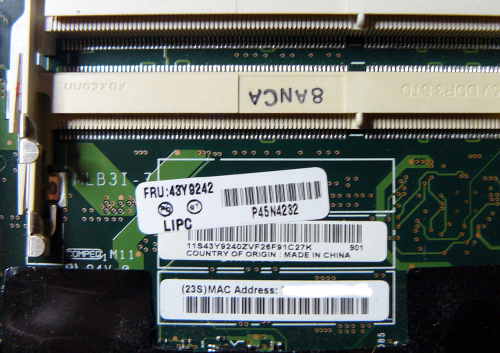126 lines
4.5 KiB
Markdown
126 lines
4.5 KiB
Markdown
---
|
|
title: Changing the MAC address
|
|
x-toc-enable: true
|
|
...
|
|
|
|
Introduction (GM45+e1000)
|
|
=========================
|
|
|
|
This section is applicable to all libreboot-supported laptops with the
|
|
mobile 4 series chipset (as shown in `$ lspci`)
|
|
that use the e1000 ethernet controller (e.g. T400, X200).
|
|
The R500 is an exception to this as it does not use the built-in e1000.
|
|
|
|
On all these laptops, the
|
|
[MAC address](https://en.wikipedia.org/wiki/MAC_address)
|
|
for the built-in gigabit ethernet controller is stored inside the flash chip,
|
|
along with libreboot and other configuration data. Therefore, installing
|
|
libreboot will overwrite it.
|
|
|
|
Thus, for these laptops, prebuilt libreboot already contains a generic
|
|
MAC address in the configuration section. This address is `00:f5:f0:40:71:fe
|
|
in builds before 2018-01-16 and `00:4c:69:62:72:65` (see the ascii character
|
|
set) afterwards.
|
|
Unless you change it, your computer will boot and use it. This can lead
|
|
to network problems if you have more than one libreboot computer on
|
|
the same layer2 network (e.g. on the same network switch). The switch
|
|
(postman) will simply not know who to deliver to as the MAC (house) addresses
|
|
will be the same.
|
|
|
|
To prevent these address clashes, you can either modify prebuilt libreboot
|
|
to use an address of your own choosing or you can change the address in your
|
|
operating system's boot scripts.
|
|
|
|
In either case, it is a good idea to write down the address that your
|
|
computer originally had.
|
|
|
|
Obtaining the existing MAC address
|
|
==================================
|
|
|
|
The existing MAC address may be obtained by the following methods:
|
|
|
|
1. Run `ip link` or `ifconfig` in a terminal/console/shell;
|
|
find your ethernet device (e.g., **enpXXX** or **ethXXX**),
|
|
and look for a set of 12 colon-delimited
|
|
[hexadecimal digits](https://en.wikipedia.org/wiki/Hexadecimal).
|
|
For example: `00:f3:f0:45:91:fe`.
|
|
|
|
* `$ ip link
|
|
|
|
... link/ether ??:??:??:??:??:?? brd ...
|
|
|
|
* Alternatively:
|
|
|
|
ifconfig
|
|
|
|
... ether ??:??:??:??:??:?? txqueuelen ...
|
|
|
|
|
|
2. Otherwise you can read the white label that is often found on the
|
|
motherboard under the memory sticks:
|
|

|
|
|
|
3. The MAC address is usually listed on the laptop chassis as well. This one
|
|
will be incorrect if the motherboard was changed and the stickers were not
|
|
updated.
|
|
|
|
Changing the MAC address in the operating system
|
|
================================================
|
|
|
|
There are three portable ways of doing so:
|
|
|
|
1. Using the new iproute2 package:
|
|
|
|
ip link set <interface> down
|
|
|
|
ip link set dev <interface> address 00:4c:69:62:72:65
|
|
|
|
ip link set <interface> up
|
|
|
|
|
|
2. Using the old `ifconfig` command:
|
|
|
|
ifconfig <interface> hw ether 00:4c:69:62:72:65
|
|
|
|
|
|
3. Using the macchanger package.
|
|
|
|
You can use use of these three methods in your operating system's
|
|
init scripts or you can use your operating system's own networking
|
|
configuration. Refer to your operating system's documentation for
|
|
how to do this.
|
|
|
|
Changing the MAC address on X200/T400/T500/W500
|
|
===============================================
|
|
|
|
On GM45 laptops with ICH9M southbridge and Intel PHY module, the MAC address
|
|
is hardcoded in boot flash, which means it can be changed if you re-flash.
|
|
|
|
See [ich9utils documentation](../install/ich9utils.md)
|
|
|
|
If *all* you want to do is change the MAC address, you might try `nvmutil`
|
|
instead. See notes below:
|
|
|
|
Changing the MAC address on ivybridge/sandybridge/haswell (e.g. X230/T440p)
|
|
=========================================================
|
|
|
|
See [nvmutil documentation](../install/nvmutil.md)
|
|
|
|
This tool was originally written for changing the MAC address on Intel
|
|
Sandybridge, Ivybridge and Haswell platforms, but it can be used on any
|
|
platform with a valid GbE region in flash, where an Intel Flash Descriptor
|
|
is used; this includes older GM45+ICH9M machines supported by Libreboot.
|
|
|
|
The `ich9utils` program is more useful in an lbmk context, because it
|
|
generates an entire Intel Flash Descriptor and GbE region from scratch;
|
|
coreboot has a similar method in its build system, using its own utility
|
|
called bincfg, but this tool is unused in lbmk.
|
|
|
|
No tool like ich9utils exists for these boards yet, but lbmk includes the IFD
|
|
and GbE files in-tree (Intel ME is handled by extracting from Lenovo updates,
|
|
which the build system automatically fetches from the internet).
|
|
|
|
You can use `nvmutil` to change the existing MAC address in a GbE region. This
|
|
sets the "hardcoded" MAC address, typically a globally assigned one set by
|
|
the vendor.
|